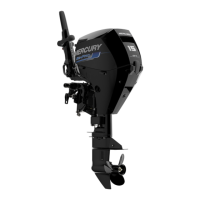BATTERY CHARGING AND STARTING SYSTEMS
Page 2B-4 90-826883R2 JUNE 1998
Battery
Precautions
Whenchargingbatteries,anexplosivegasmixtureformsineachcell.Aportionofthisgas
escapes thru holes in vent plugs and may form an explosive atmosphere aroundbattery
ifventilation ispoor.Thisexplosivegasmayremaininoraroundbatteryforseveralhours
after it has been charged. Sparks or flames can ignite this gasand cause an internalex-
plosion which may shatter the battery.
The following precautions should be observed to prevent an explosion.
1. DO NOT smoke near batteries being charged or which have been charged very re-
cently.
2. DO NOT break live circuits at terminals of batteries because a spark usually occurs
at the point where a live circuit is broken. Always be careful when connecting or dis-
connectingcableclampsonchargers.Poorconnectionsareacommoncauseofelec-
trical arcs which cause explosions.
3. DO NOT reverse polarity of battery cables on battery terminals.
CAUTION
If battery acid comes into contact with skin or eyes, wash skin immediately with
a mild soap. Flush eyes with water immediately and see a doctor.
Recommended Battery
A 12 volt battery with a “Marine Cranking Amperage” rating minimum of 465 amperesor
or a “Cold Cranking Amperage” of 400.
Operating Engine Without Battery
If desired (or in an emergency), engines equipped with an alternator can be started and
operatedwithout abattery(either disconnectedorremoved) if “WARNING”,below, isfol-
lowed.
WARNING
Before operating engine with battery leads disconnected from battery, discon-
nectstator leads (Yellow) fromrectifier. Insulate (tape)stator lead ringterminals.
Specific Gravity Readings
Use a hydrometer to measure specific gravity of electrolyte in each cell.
22532
a
a - Hydrometer

